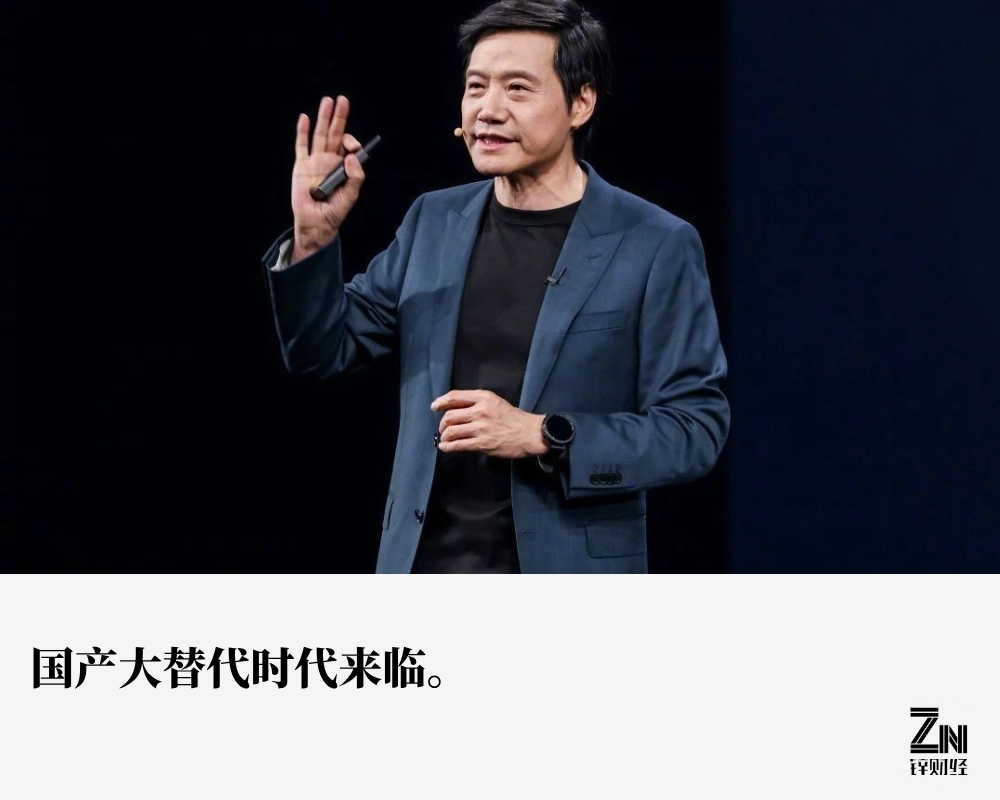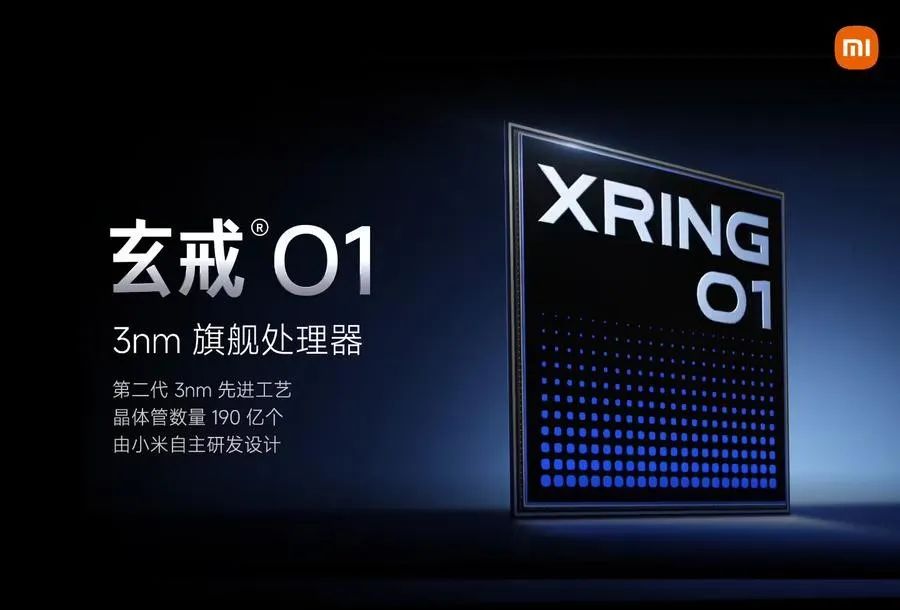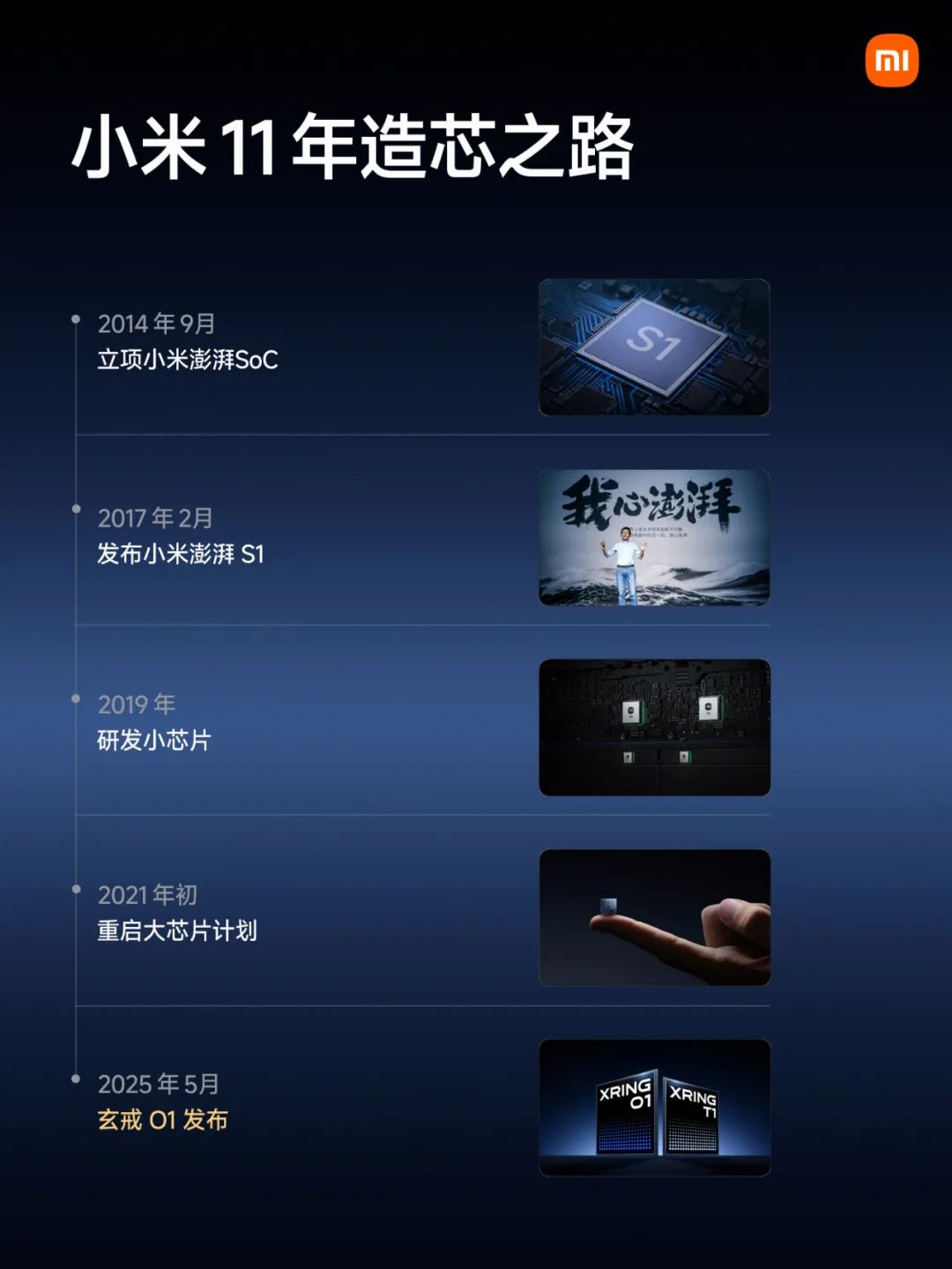Xiaomi Unveils Xuanjie O1: China's Leap Forward in Single-Chip Technology
![]() 05/23 2025
05/23 2025
![]() 986
986

Author: Chuan Chuan
Editor: Da Feng
On the evening of May 22, 2025, at Xiaomi's 15th-anniversary strategic conference held at the Beijing National Convention Center, Lei Jun held aloft a fingernail-sized chip, proclaiming, "This is the fruit of Xiaomi's decade-long dedication and 13.5 billion yuan invested in R&D."

As the 3nm process parameters and performance data of Xuanjie O1 flashed across the big screen, the audience erupted in thunderous applause.
This was not merely a product launch; it marked a significant milestone—the first time mainland China has achieved mass production of 3nm mobile SoC chips, potentially reshaping the global mobile chip market.
Ten Years of Perseverance: Xiaomi's "Chip Odyssey" and Domestic Breakthrough
In 2014, Xiaomi embarked on the "Pengpai Plan" and released its first self-developed SoC, the Pengpai S1, in 2017. However, due to insufficient technical maturity, this mid-to-high-end chip struggled with overheating issues, receiving a lukewarm market reception.
Faced with criticism, Lei Jun opted for a "strategic pause" while secretly nurturing the spark of chip R&D. During this challenging transformation phase, Xiaomi shifted its focus to "small chips," successively launching fast-charging chips, image chips, and more, with a cumulative investment exceeding 5 billion yuan.
The turning point came in 2021. On the same day Xiaomi announced its foray into the automotive industry, it reignited its "big chip" strategy, this time aiming directly at high-end flagship SoCs. "Only by mastering the SoC can we truly define a premium user experience," Lei Jun wrote in an internal letter.

The team expanded from 2,000 to 2,500 people, with annual R&D investment soaring from 2 billion yuan to 6 billion yuan, reaching a cumulative total of over 13.5 billion yuan. In May 2025, the mass production of Xuanjie O1 positioned Xiaomi as the fourth company globally, after Apple, Qualcomm, and MediaTek, to possess self-developed 3nm mobile SoCs.
For Xiaomi, the significance of Xuanjie O1 transcends mere technological advancement. It serves as the "technical ID" of Xiaomi's premiumization strategy and the cornerstone of its closed ecosystem.
Xiaomi 15S Pro and Pad 7 Ultra, powered by Xuanjie O1, enable seamless collaboration across mobile phones, automobiles, and IoT devices. Lei Jun revealed that Xiaomi will invest another 200 billion yuan in R&D over the next five years, focusing on underlying technologies such as lithography machines and EDA tools, "We aim to ensure that Chinese technology enterprises are no longer 'throttled' by others."
The Path Forward: How Domestic Chips Are Reshaping Global Rules
The birth of Xuanjie O1 epitomizes China's semiconductor industry's transition from "follower" to "leader".
Its technical specifications rival those of Apple's A18 Pro, utilizing TSMC's second-generation 3nm process with a transistor density of 19 billion, offering a 40% boost in CPU performance and double the AI computing power compared to 7nm chips.
More importantly, Xiaomi compensated for manufacturing process shortcomings through architectural innovation—despite TSMC's foundry constraints, it achieved a harmonious balance between performance and power consumption through deep collaboration and optimization of software and hardware.
Behind this breakthrough lies the collective rise of domestic industrial chains. From Huaxi Industries' 12-inch silicon wafers to Depond Technology's 3D packaging technology and ZTE Microelectronics' 5G-A solutions for RF modules, the mass production of Xuanjie O1 has spurred the participation of hundreds of Chinese enterprises.

Professor Sun Chengliang from Wuhan University commented, "In the past, we often said 'it's better to buy than to make,' but now we can proudly declare 'designed in China, globally compatible.'"
The ascendancy of domestic chips is redefining the rules of the global semiconductor industry. Previously, 3nm chip design was dominated by Apple, Qualcomm, and MediaTek, and Xiaomi's entry directly elevates the competitive bar.
Industry analysts predict that the mass production of Xuanjie O1 will compel international giants to adjust their pricing strategies, with global mobile chip prices expected to decline by 10%-15%. The deeper impact lies in proving that Chinese enterprises are fully capable of achieving "lane-changing overtaking" in cutting-edge fields.
The Journey to Breakthrough: From "Breaking the Blockade" to "Defining Standards"
The breakthrough in China's chip industry was not achieved overnight.
In 2018, US sanctions against ZTE awakened China's technology community to the "pain of lacking chips"; in 2020, Huawei's miraculous resurgence with its Kirin chips ignited the spark of independent innovation. Xiaomi's journey is a typical footnote to this narrative.
"Breaking the Wall" of Technological Blockade
The 3nm process has long been monopolized by TSMC and Samsung, but Xiaomi adopted a "design-first" strategy. By developing its own architecture and establishing a joint laboratory with TSMC, Xiaomi achieved domestic substitution in key areas like EDA tools and IP cores. While Xuanjie O1's transistor count (19 billion) hasn't reached the US regulatory threshold of 30 billion, its design capabilities are nearing the international apex.
"Dimensional Reduction Attack" of Ecological Collaboration
Xiaomi's unique advantage lies in its "comprehensive ecosystem encompassing people, cars, and homes." Xuanjie O1 is not limited to mobile phones but also empowers products like Xiaomi's YU7 electric vehicle (with 700 TOPS of intelligent driving computing power) and Pad 7 Ultra (featuring PC-level WPS multi-window split-screen). This cross-scenario collaboration elevates chip R&D from product-centric competition to ecosystem-centric competition.
"Chinese Solution" for Cost Control
Faced with the billions of dollars in R&D costs for 3nm chips, Xiaomi explored a model of "cost-sharing across flagship models and reuse in automotive scenarios." The NPU unit of Xuanjie O1 concurrently serves mobile phone image optimization and automotive autonomous driving, reducing R&D costs by 30%. This "ecological feedback to R&D" path provides a replicable model for future entrants.
Xiaomi's Breakthrough is Part of a Broader Movement
From Huawei's resurgence with Kirin chips to BYD's localization of IGBT chips and Yangtze Memory Technologies' mass production of 3D NAND flash memory, Chinese technology enterprises are mounting a "group army" offensive.
In 2024, China's integrated circuit export value surpassed 1 trillion yuan for the first time, with patent applications accounting for 47.5% of the global total. Behind these figures lie the silent efforts of countless enterprises.
This rise is reshaping the global technology landscape.
In the smartphone sector, Huawei and Xiaomi have achieved premium breakthroughs with their self-developed chips, reducing Apple's market share from 20% in 2023 to 12% in 2025.
In the automotive sector, BYD and NIO have boosted intelligent driving computing power to 700 TOPS through chip-vehicle collaboration, rivaling Tesla's FSD.
In the AI sector, Baidu and SenseTime's algorithm frameworks have been open-sourced to the global developer community, establishing "Chinese standards".
At the policy level, "Made in China 2025" lists semiconductors as a strategic industry, with the third phase of the National IC Industry Investment Fund raising 300 billion yuan.
At the enterprise level, giants like Xiaomi and Huawei are accelerating their layout in "throttled" areas, with SMIC achieving a 95% yield rate for its 14nm process.
At the talent level, universities such as Tsinghua and Peking have established IC colleges, training over 100,000 professionals annually.
As Lei Jun remarked at the conference, "Some may see our success as sudden, but they don't realize that Xiaomi has quietly persevered for 11 years." From Pengpai S1 to Xuanjie O1, Xiaomi has demonstrated through a decade of effort that the rise of Chinese technology enterprises is not a matter of luck but rather the result of the determination to "sit on a bench for ten years of coldness" and the courage to "dare to change the world."







